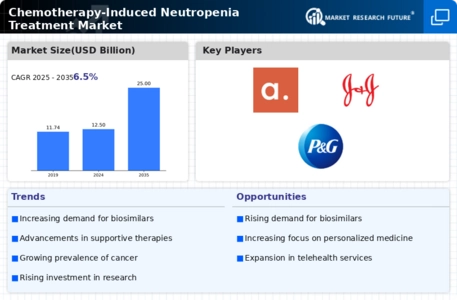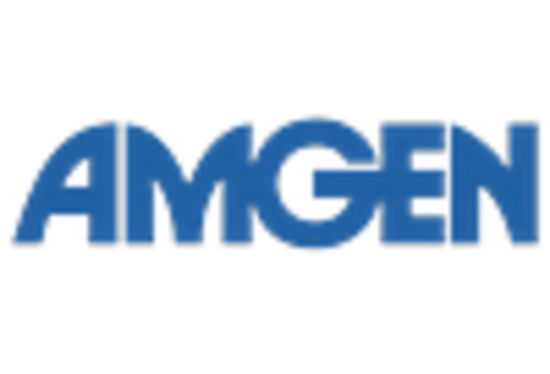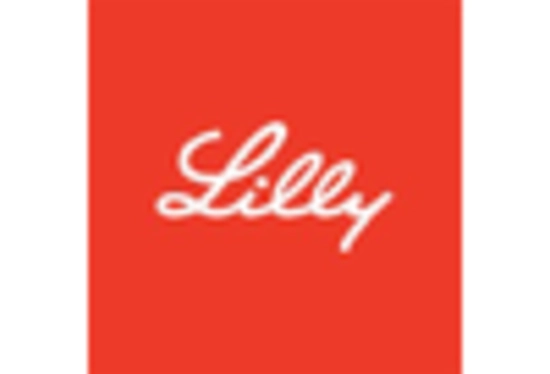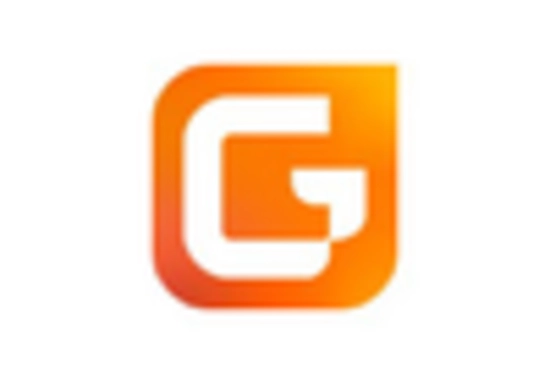Rising Incidence of Cancer
The increasing incidence of cancer worldwide is a primary driver for the Chemotherapy-Induced Neutropenia Treatment Market. As cancer rates rise, the demand for effective treatment options, including those addressing chemotherapy-induced neutropenia, escalates. According to recent statistics, cancer cases are projected to increase significantly, leading to a higher number of patients undergoing chemotherapy. This trend necessitates the development and availability of therapies that can mitigate the side effects of chemotherapy, such as neutropenia. Consequently, pharmaceutical companies are investing in research and development to create innovative treatments, thereby expanding the Chemotherapy-Induced Neutropenia Treatment Market. The growing patient population is likely to drive market growth as healthcare providers seek to improve patient outcomes and reduce the risk of infections associated with low neutrophil counts.
Advancements in Drug Development
Advancements in drug development are significantly influencing the Chemotherapy-Induced Neutropenia Treatment Market. The introduction of novel agents, such as granulocyte colony-stimulating factors (G-CSFs), has transformed the management of neutropenia. These agents are designed to stimulate the production of neutrophils, thereby reducing the incidence of febrile neutropenia in patients undergoing chemotherapy. Recent data indicates that the use of G-CSFs has led to a marked decrease in hospitalizations due to infections, which is a common complication of chemotherapy. As research continues to unveil new therapeutic options, the Chemotherapy-Induced Neutropenia Treatment Market is expected to expand, driven by the need for more effective and safer treatments. Furthermore, the ongoing clinical trials and regulatory approvals of new drugs are likely to enhance the treatment landscape, providing healthcare professionals with a broader array of options to manage this condition.
Increase in Cancer Treatment Options
The increase in cancer treatment options is a notable driver for the Chemotherapy-Induced Neutropenia Treatment Market. As the landscape of cancer therapies evolves, more patients are receiving chemotherapy as part of their treatment regimen. This rise in chemotherapy utilization correlates with a higher incidence of chemotherapy-induced neutropenia, necessitating effective management strategies. The introduction of combination therapies and targeted treatments has expanded the range of options available to oncologists, which may inadvertently lead to a greater incidence of neutropenia. Consequently, the demand for treatments specifically addressing this condition is likely to grow. The Chemotherapy-Induced Neutropenia Treatment Market is expected to benefit from this trend, as healthcare providers seek to optimize treatment regimens while minimizing the risk of neutropenia-related complications.
Regulatory Support for New Treatments
Regulatory support for new treatments is a significant factor propelling the Chemotherapy-Induced Neutropenia Treatment Market. Regulatory agencies are increasingly recognizing the need for effective therapies to manage chemotherapy-induced side effects, including neutropenia. The expedited approval processes for innovative drugs aimed at treating neutropenia have encouraged pharmaceutical companies to invest in research and development. This regulatory environment fosters innovation and facilitates the introduction of new therapies into the market. As a result, the Chemotherapy-Induced Neutropenia Treatment Market is likely to witness an influx of novel treatment options that can improve patient care. Furthermore, the collaboration between regulatory bodies and industry stakeholders is expected to enhance the speed at which new therapies are brought to market, ultimately benefiting patients who require effective management of neutropenia.
Growing Awareness of Neutropenia Management
Growing awareness of neutropenia management among healthcare professionals and patients is a crucial driver for the Chemotherapy-Induced Neutropenia Treatment Market. Educational initiatives and guidelines from oncology associations have emphasized the importance of monitoring and managing neutropenia in cancer patients. This heightened awareness has led to increased screening and early intervention, which are essential for improving patient outcomes. As a result, healthcare providers are more likely to prescribe treatments that address neutropenia, thereby boosting the demand within the Chemotherapy-Induced Neutropenia Treatment Market. Additionally, patient advocacy groups are playing a vital role in educating patients about the risks associated with neutropenia and the available treatment options, further driving market growth. The focus on proactive management strategies is likely to enhance the overall quality of care for patients undergoing chemotherapy.

















Leave a Comment